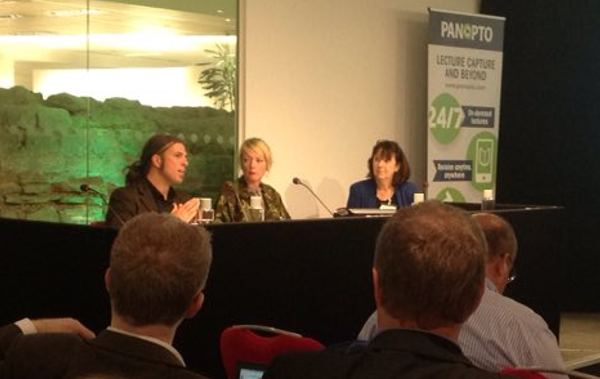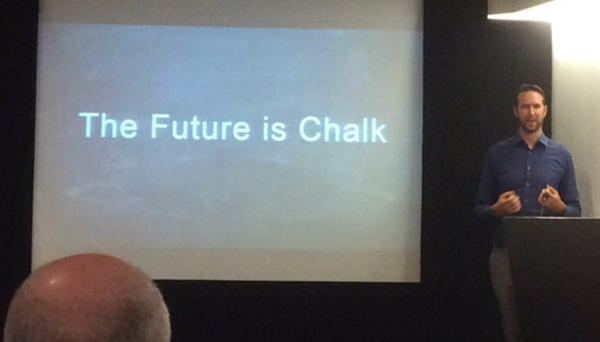- Uncategorized
Reflections on the Panopto Annual Conference 2015: ‘The Future of Video For Learning’
Last week we hosted our seventh Panopto Conference for the EMEA region. The conference – now an annual fixture in the calendar – first began as a forum to help our users share best practice on lecture capture, the flipped classroom and more. While the conference still retains a strong ‘user community’ feel, it’s now open to anyone in the education sector who wants to discuss new ways to use video to enhance the student experience. The event has grown rapidly, and this year we were delighted that over 200 delegates representing 90 separate organisations registered to attend. The delegates came from a more diverse range of countries than ever before – with representatives from Denmark, the Netherlands, Belgium, Portugal, Ireland, Latvia, Turkey, Germany, and of course, the UK, in attendance.
As the overall theme of the event was ‘the future of video for learning’, I kicked off the morning sessions with a look at some of the predictions for the future for higher education and technology that I’ve seen during my 30 years in the education sector. Some, inevitably, proved accurate, while others – notably, the death of the printed book – fell wide of the mark.
My introduction was designed to highlight some important themes that would recur throughout the rest of the day. One such theme was the importance of blended learning – a theme that was explored more thoroughly during the opening keynote from Graham Brown-Martin, which included some thought-provoking observations on digital/physical crossover and on the role of the 21st century university in preparing students for a future full of uncertainties and challenges. Illustrated with quotes and video clips from thinkers such as Seth Godin, Keri Facer and Noam Chomsky, Graham dived right into some big questions. These included – what is university for? Enlightenment or indoctrination? The next stop on the conveyor belt after school? He also posed the question, now that the internet has removed the scarcity value of the lecture, is the value of higher education more about who you sit next to and proving you graduated? Graham also highlighted that good lecturing is a craft that can’t be replaced by videos or even AI, and that technology needs to enable transformation, not just reinforce 19th Century methods of teaching. Graham concluded that “lecturers will not be replaced by technology, but agile lecturers who use technology will replace those who don’t.”
 A moment from the student panel
A moment from the student panelFollowing on from the keynote, we then welcomed Simon Eder from youth market research specialists Voxburner, who put a different twist on the idea of blended learning by presenting research on student views of the balance (or blend) between formal and informal learning approaches and, of course, their views on technology for learning. While many nuanced points emerged, there were also broader patterns. For instance, 84% of the 500 students surveyed agreed or strongly agreed with the statement ‘technology improves my ability to learn’. Video emerged as a key learning medium, with 72% of students saying that they had used an online video platform such as YouTube or Vimeo to acquire knowledge or teach themselves a new skill. The research – commissioned specifically for the event – also asked students questions like ‘what technology could you not live without?’ and ‘what is the one thing your university could do technology-wise to enhance your learning experience?’. We will be releasing some of the further findings on this blog in the coming weeks – so watch this space!
After seeing these broader student trends, we were then joined by students from Newcastle University, the University of West London and the University of Chichester who talked about their experiences of using video directly – some having had access to on-demand lectures and one student having had a module delivered using the flipped classroom methodology. The students all agreed that having access to recorded lectures didn’t have a noticeable effect on lecture attendance, but the panel had more diverse views on whether, for example, it made a difference to have recordings that included video, audio, slides and screen capture, or whether just audio synced with slides was enough for effective engagement with the content. It was a great reminder that different approaches work for different types of learners. All agreed that engaging with course content in more than one type of way was great for knowledge retention and understanding.
 A moment from the academic panel
A moment from the academic panelAs a counterpoint to the student view, we then moved to an academic panel, featuring Jennie White from the University of Chichester, Ann Draycott from the University of Derby and Dr Martin Khechara from the University of Wolverhampton. Each academic has used video in a range of ways – Jennie, for instance, to flip the classroom; Ann to offer video feedback on student work and create video tutorials; and Martin to unpack assessment and assignment briefs, create tutorials and more. They discussed how they were making video work for them in practice as well as how they were encouraging colleagues to use technology more actively in the classroom.
The last morning session saw a presentation from Panopto’s co-founder and CEO Eric Burns. His presentation: ‘Strategy, Serendipity, and Surprises’ took a look at the past fifteen years – from the very beginnings of the Carnegie Mellon University project that would later become to Panopto, right up to the present day – to consider what we correctly anticipated technology-wise and conversely what took us (and others in the sector) by surprise. He then rounded off with some predictions about potential futures for video-based learning in the education sector.
 Panopto CEO Eric Burns presenting
Panopto CEO Eric Burns presentingThe afternoon saw delegates split into two parallel sessions – one more focused on technical or product-related content, the other more on teaching and learning or use cases at customer universities. The more technically-oriented sessions included a look back at product development since the last conference, along with sneak-peek demos of features coming up in the next release. It also saw the return of the ever popular ‘Ask the Experts/Tell the Experts’ session – where delegates engage in open Q&A with senior members of the Panopto team (including CEO Eric Burns). The technical sessions were brought to a close by the University of Essex’s Ben Steeples, who covered how the university has used Panopto’s API to scale lecture capture campus-wide and facilitate a specialist medical recording set-up for their nursing students.
In the other room, delegates heard from three institutions on how they are using Panopto to enhance teaching and learning at their universities. Rob Higson and Ann Draycott from the University of Derby gave a deep-dive on how they use Panopto to enhance the learning experience for BA Hons Fashion students – namely through the Flexible Feedback Project. This was then followed by Gemma Witton and Matthew Green from the University of Wolverhampton talking about how they are capturing content for science subjects in the university’s brand new Science Centre, which has reimagined the idea of the ‘learning space’ for science and integrated technology throughout. Finally, having heard a lot about youth trends and the school leaver experience throughout the day, Damien Darcy from Birkbeck College, University of London, gave us a different perspective – that of the mature student or non-traditional learner. He addressed many of the myths that surround both their use of technology for study purposes and their expectations.
As the formal sessions drew to a close, it was inspirational to reflect on all the different ways the solution is now being used by our customers. While lecture capture is, of course, still a core use case for over 90% of our customers, we’ve seen a massive rise in other video uses – from the flipped classroom to video feedback and from staff training to video assignments submitted by students themselves. When I think about what the future of video for learning holds, that future is increasingly diverse and will be tailored more and more towards the teaching and learning approaches that most engage the students institutions are trying to reach.
Want to start using video at your educational institution? Contact our team today for a free trial of Panopto.


